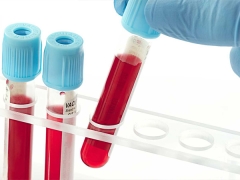On the inheritance of the blood group. What type of blood will the baby have?
A common classification of blood groups is the AB0 system. Let's see how a child’s blood type is inherited and what are the options, if parents have the same or different groups, and also how the Rh factor is inherited.
About, How to make an analysis on the determination of blood type in a childread in another article.
Mendel's Law
Mendel studied the transfer of genes from parents to offspring, as a result of which he drew conclusions about how certain features are inherited. These conclusions he designed in the form of laws.
He learned that a child receives one gene from each parent, so a child in a pair of genes has one maternal gene, and the second paternal gene. In this case, the inherited trait may manifest (it is called dominant) or not manifest (it is recessive).
Regarding blood groups, Mendel found out that genes A and B are dominant (they encode the presence of antigens on the surface of red blood cells), and recessive is gene 0. This means that when genes A and B are combined, both genes will encode the presence of agglutinogens, and the blood group will be the fourth. If genes A and 0 or B and 0 are passed to the child, then the recessive gene will not appear, respectively, in the first case there will be only agglutinogens A (the child will have group 2), and in the second - agglutinogen B (the child will have the third group) .
AB0 system
This system for the typology of blood groups began to be used in 1900, when it was discovered that there were antigens in the blood (on red blood cells), which were called agglutinogens, and also antibodies to them, which they began to call agglutinins. Agglutinogens are A and B, and agglutinins are referred to as alpha and beta. Possible combinations of such proteins create 4 groups:
- 0 (first) - contains alpha agglutinin and beta agglutinin.
- A (second) - contains beta agglutinin and A agglutinogen.
- B (third) - contains alpha agglutinin and B agglutinogen.
- AB (fourth) - contains A agglutinogen and B agglutinogen.
Rh-factor system
In 1940, another protein was found on the surface of red blood cells, which was called rhesus of blood. It is determined in about 85% of people, marked as Rh +, and the blood of such people is called Rh-positive. The remaining 15% of people of this antigen in the blood is not detected, their blood is Rh-negative and is designated as Rh-.
If the blood types of mom and dad are the same
Even if the blood group of the mother and father is the same, due to the possible carriage of the recessive gene 0, there may be several options for the baby’s blood group.
|
Parents blood type |
Genotype |
Baby blood type |
|
First |
00+00 |
First (00) |
|
The second |
AA + AA |
Second (AA) |
|
The second |
AA + A0 |
The second (AA or A0) |
|
The second |
A0 + A0 |
First (00) or second (AA or A0) |
|
Third |
BB + BB |
Third (BB) |
|
Third |
BB + B0 |
Third (B0 or BB) |
|
Third |
B0 + B0 |
First (00) or third (B0 or BB) |
|
Fourth |
AB + AB |
Second (AA), third (BB) or fourth (AB) |
If the blood types of mom and dad are different
With different groups of parents, there will be more variants of gene transfer.
|
Mom's blood type |
Father's blood type |
Baby blood type |
|
First (00) |
Second (AA) |
Second (A0) |
|
First (00) |
Second (A0) |
First (00) or second (A0) |
|
First (00) |
Third (BB) |
Third (B0) |
|
First (00) |
Third (B0) |
First (00) or Third (B0) |
|
First (00) |
Fourth (AB) |
Second (A0) or third (B0) |
|
Second (AA) |
First (00) |
Second (A0) |
|
Second (AA) |
Third (BB) |
Fourth (AB) |
|
Second (AA) |
Third (B0) |
Second (A0) or fourth (AB) |
|
Second (AA) |
Fourth (AB) |
Second (AA) or fourth (AB) |
|
Second (A0) |
First (00) |
First (00) or second (A0) |
|
Second (A0) |
Third (BB) |
Third (B0) or fourth (AB) |
|
Second (A0) |
Third (B0) |
The first (00), the second (A0), the third (B0) or the fourth (AB) |
|
Second (A0) |
Fourth (AB) |
The second (AA or A0), the third (B0) or the fourth (AB) |
|
Third (BB) |
First (00) |
Third (B0) |
|
Third (BB) |
Second (AA) |
Fourth (AB) |
|
Third (BB) |
Second (A0) |
Third (B0) or fourth (AB) |
|
Third (BB) |
Fourth (AB) |
Third (BB) or fourth (AB) |
|
Third (B0) |
First (00) |
First (00) or Third (B0) |
|
Third (B0) |
Second (AA) |
Second (A0) or fourth (AB) |
|
Third (B0) |
Second (A0) |
The first (00), the second (A0), the third (B0) or the fourth (AB) |
|
Third (B0) |
Fourth (AB) |
The second (A0), the third (BB or B0) or the fourth (AB) |
|
Fourth (AB) |
First (00) |
Second (A0) or third (B0) |
|
Fourth (AB) |
Second (AA) |
Second (AA) or fourth (AB) |
|
Fourth (AB) |
Second (A0) |
The second (AA or A0), the third (B0) or the fourth (AB) |
|
Fourth (AB) |
Third (BB) |
Third (BB) or fourth (AB) |
|
Fourth (AB) |
Third (B0) |
The second (A0), the third (BB or B0) or the fourth (AB) |
Rh inheritance
This protein is inherited according to the dominant principle, that is, its presence is encoded by the dominant gene. For example, if this gene is denoted by the letter D, then the Rh-positive person may have the DD or Dd genotype. With the dd genotype, the blood will be Rh-negative.
|
Rh factor mom |
Father's rhesus factor |
Rh factor in a child |
|
Minus (dd) |
Plus (DD) |
Plus (Dd) |
|
Minus (dd) |
Plus (Dd) |
Plus (Dd) or minus (dd) |
|
Plus (DD) |
Plus (DD) |
Plus (DD) |
|
Plus (DD) |
Plus (Dd) |
Plus (DD or Dd) |
|
Plus (Dd) |
Plus (DD) |
Plus (DD or Dd) |
|
Plus (DD) |
Minus (dd) |
Plus (Dd) |
|
Plus (Dd) |
Minus (dd) |
Plus (Dd) or minus (dd) |
Table of options
|
Father's blood type |
|||||
|
First |
The second |
Third |
Fourth |
||
|
Mom's blood type |
First |
I |
I or II |
I or III |
II or III |
|
The second |
I or II |
I or II |
Any |
II, III or IV |
|
|
Third |
I or III |
Any |
I or III |
II, III or IV |
|
|
Fourth |
II or III |
II, III or IV |
II, III or IV |
II, III or IV |
|
What is the probability of mutation?
Mutation, as a result of which a child with the first group can be born to a parent with the fourth group, is in 0.001% of cases. There is also the so-called Bombay phenomenon (its name is due to the frequent identification of Hindus), according to which a child may have genes A or B, but they are not phenotypically manifested. The frequency of this phenomenon is 0.0005%.











